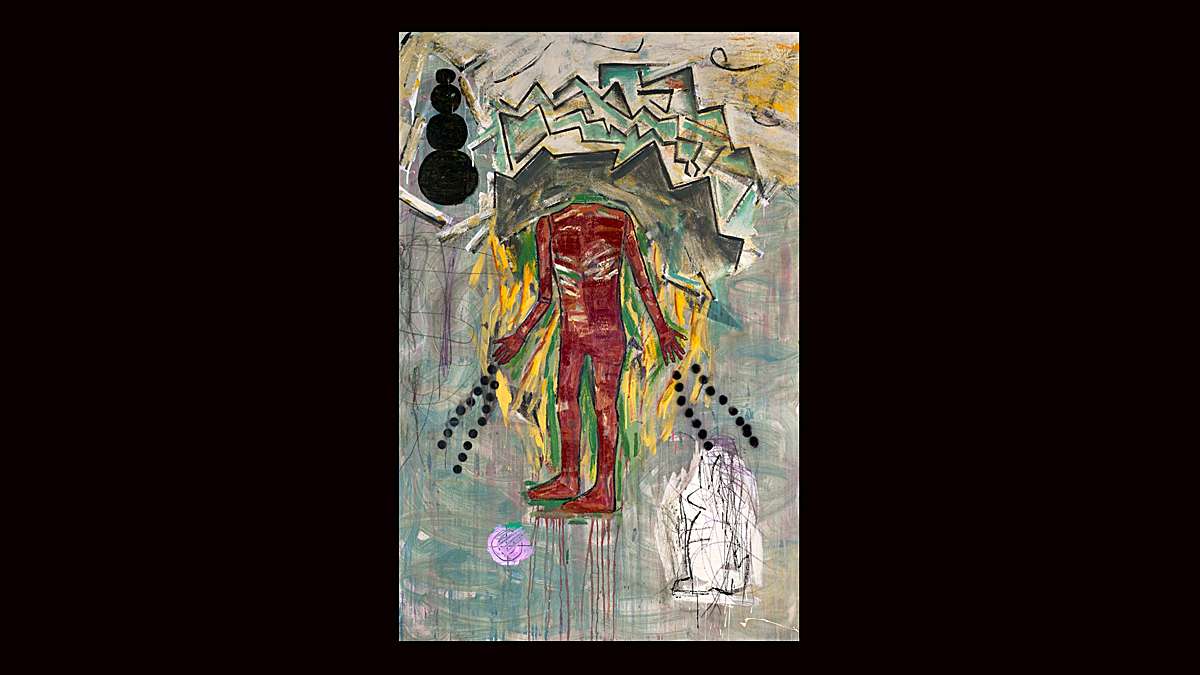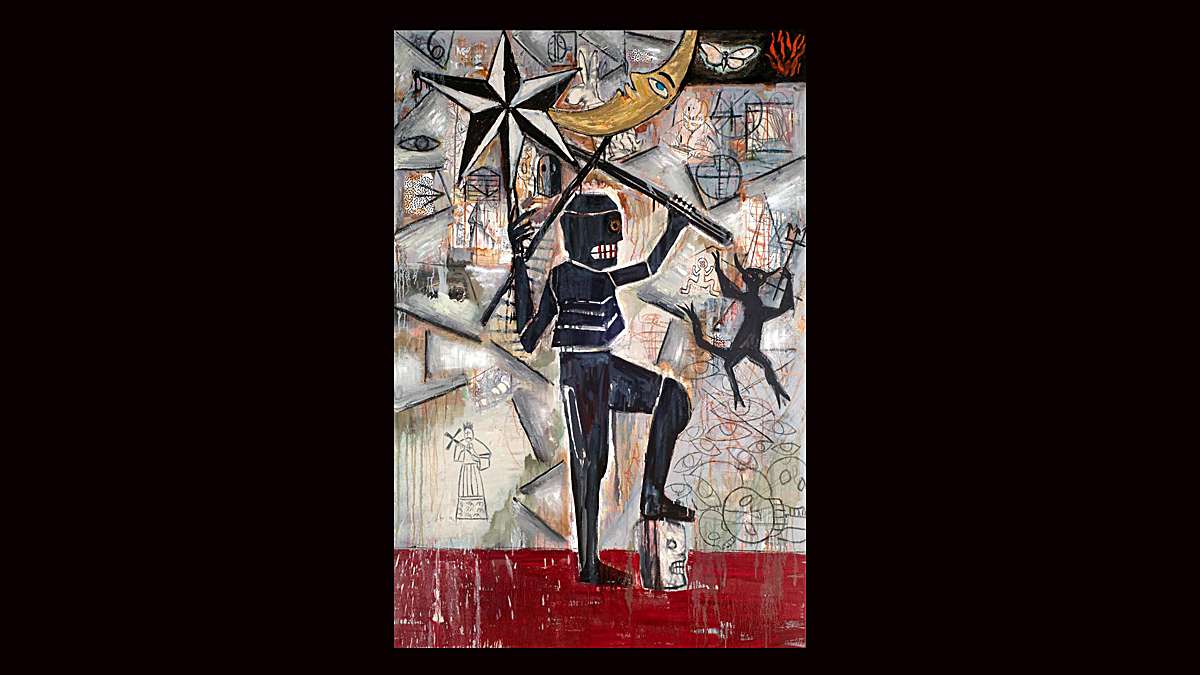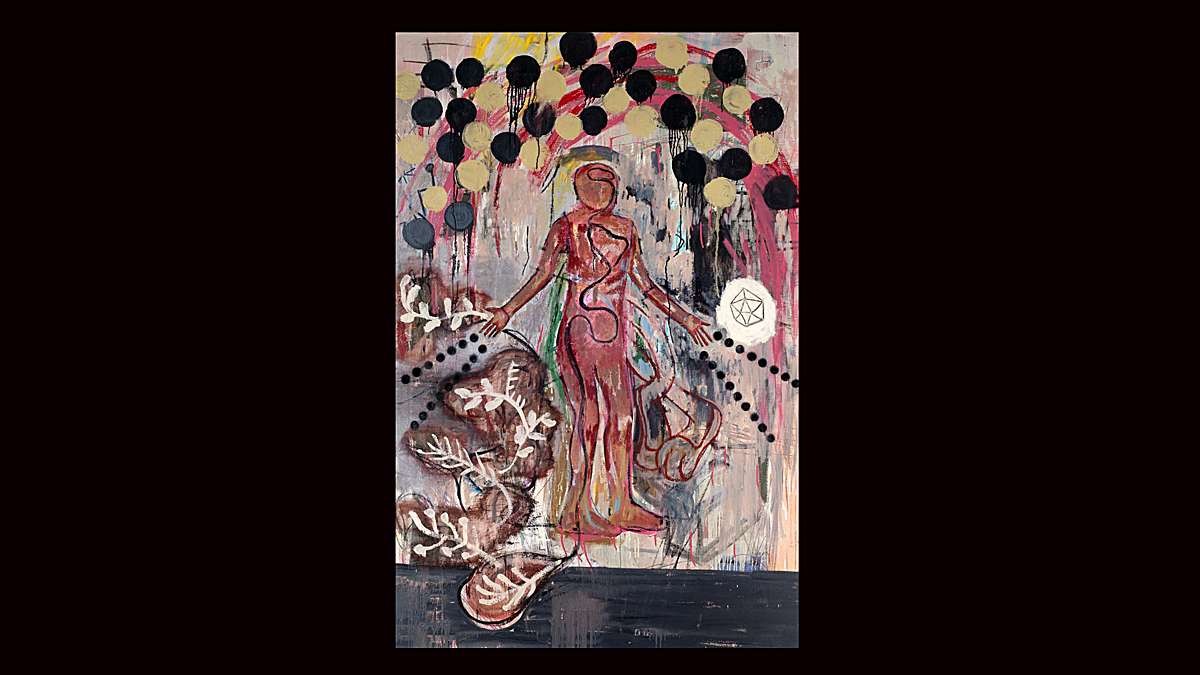Native American artists explores what it means to be an American
The buffalo was an essential part of Native American life, used in everything from religious rituals to teepee construction. Every part of the animal, from the skull and bones to the hide, was put to use. Even the dung was dried and burned as fuel. Tens of millions of bison roamed North America at the turn of the 19th-century, but after “Americans” arrived, the animal was nearly driven to extinction. Today the American Buffalo has become a symbol of Native American culture.
Native American artist Jaune Quick-to-See Smith questions patriotism, symbolism, American identity and the role of the buffalo in “What is An American?”, a wall-size print of a headless figure in Native American dress. The image is predominantly black and white, but stripes of red, white and blue gush from a hand that is tattooed with saints. The background is filled with Buffalo stamps, Mickey Mouse’s hand and ears, and a pattern of paper doll silhouettes of a Barbie-like figure. There is found poetry in the cut-and-pasted words: “Get there faster”; “Americans have big ideas”; “Shopping”; “Profit Margin.” The work of art hangs from grommets, suggesting a hanging buffalo hide.
“What is an American” is among a group of large paintings and prints by Jaune Quick-to-See Smith on view at the Bernstein Gallery, Woodrow Wilson School at Princeton University, through Aug. 4. Smith is well-known internationally for the floor pattern she designed for the Great Hall at the Denver Airport.
“In these paintings and prints, Smith expresses her concerns for our environment, corporate greed, consumerism run amok, and the rising gap between rich and poor,” says Bernstein Gallery Curator Kate Somers. “Through humor and cleverly constructed compositions, her signature visual language uses a combination of historic and literary references, including American-Indian mythology, as well as contemporary current events, to make her provocative socio-political statements.”
A prolific artist, Smith has worked in painting, printmaking, pastels and mixed media. She embeds text in her work, creating complex juxtapositions that provoke questions about stereotypes and myths about indigenous people.
Another work, “Sissy and the Plutocrats,” is a variation on the myth of Sisyphus pushing the boulder up the mountain. In this painting we see a woman pushing a shopping cart up hill, filled with a bag on which a girl sits atop. The mountain is a feast of melons, grapes, pears, asparagus, wine and roasted pheasant. Also on a platter is what looks like a roasted rat – you can see its ribs, as well as the ribs of a mangy dog following the woman up the hill. At lower right, a man – a waiter – holds out an empty platter.
Born in 1940 at St. Ignatius Jesuit Mission on the Confederated Salish and Kootenai Reservation in Montana, Smith is an enrolled member of the Flathead Nation. Descended from French, Cree and Shoshone ancestors, Jaune’s mother left her with another Indian family when she was 2. With her father, a horse trainer and trader – and binge drinker — she lived in California and then reservations and towns in Washington state. In a small cabin shared with another family, Jaune was beaten.
Her earliest memories of creating is with mud and sticks – moss and rocks were her toys. “We didn’t have a home and we never had enough to eat, so I was always making things,” she said.
The artist’s first encounter with crayons was in first grade, and when the teacher passed them out, the first thing Jaune did was to smell them. “I think when you are disadvantaged you always smell everything and taste it. It’s probably a way of testing it, and the first thing I did was crunching them in my mouth and I remember how un-flavorful the (crayon) texture was.”
Her father would draw pictures of horses in sand. When she was in second grade, she learned to read from books from the bookmobile and hid in a tree or barn to read instead of chopping wood or cleaning the corral. Jaune had to work on a farm from the age of 8, but books opened up worlds in her head.
She lived in foster homes (during her father’s drinking episodes, when she and her sister had to fen for themselves) and went to public schools where she was discriminated against for being American Indian. She was told that Indians couldn’t go to college, and that women couldn’t become artists. As a result, she learned to be resilient.
In the back of a pickup truck, alongside the Mexican and Japanese farm laborers she worked with, she went into town to see a film about Toulouse Lautrec and decided to become an artist, sending away for lessons. When she saw Ad Reinhardt’s 1940s cartoon series, “How to Look at Art in America,” she discovered her mission.
Working at a series of low paying jobs, Smith was able to put herself through school: first at Olympic Community College, earning an Associate’s degree in 1960 (where she was exposed to Robert Rauschenberg and Jasper Johns, two early influences), then earning a Bachelor of Arts degree in Art Education from Framingham State College in Massachusetts in 1976 and a Master’s degree in art from the University of New Mexico in 1980.
“I see myself as a bridge builder,” says Smith, who lives on a farm in New Mexico with adopted grandchildren. “My art, my life experience and my tribal ties are totally enmeshed. I go from one community with messages to the other, and I try to enlighten people.”
_________________________________________
The Artful Blogger is written by Ilene Dube and offers a look inside the art world of the greater Princeton area. Ilene Dube is an award-winning arts writer and editor, as well as an artist, curator and activist for the arts.
WHYY is your source for fact-based, in-depth journalism and information. As a nonprofit organization, we rely on financial support from readers like you. Please give today.








